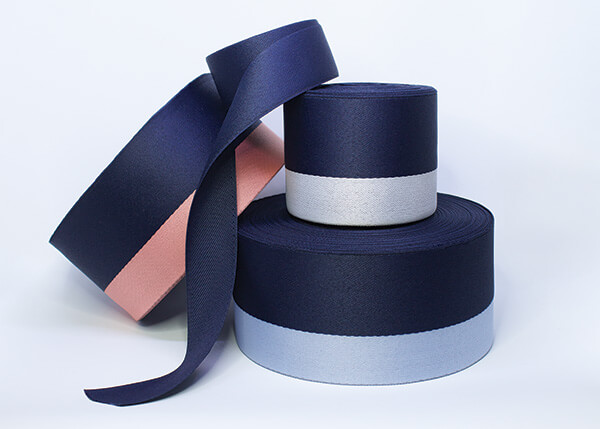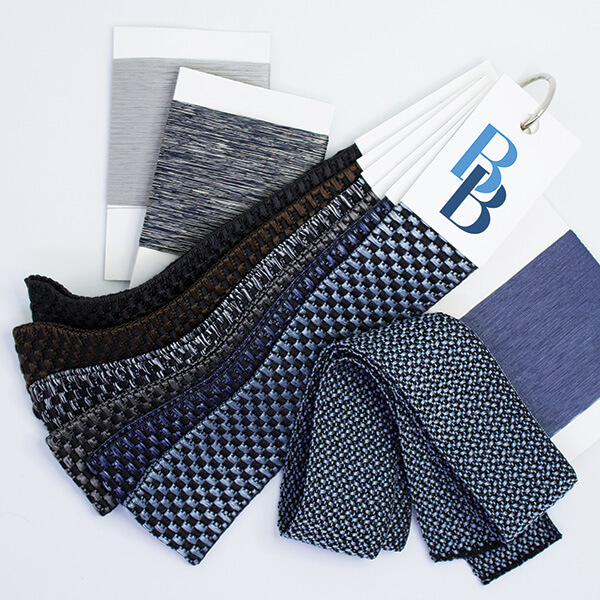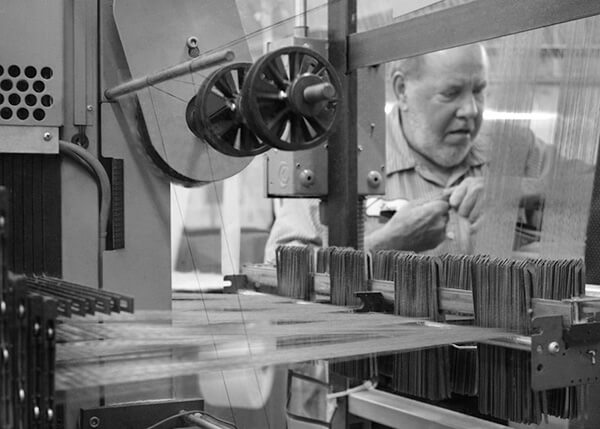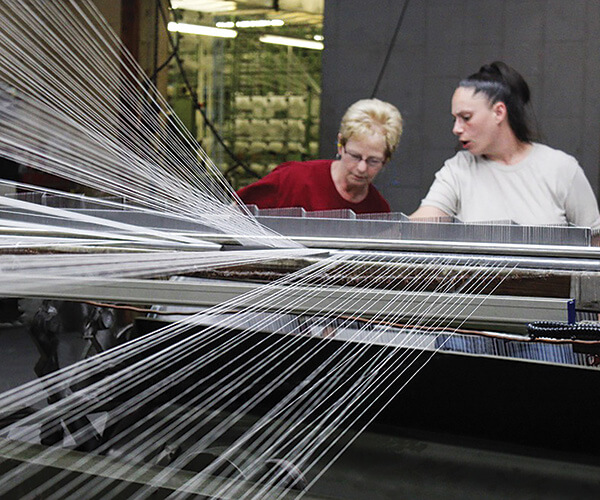Led by a cohesive team, this South Carolina-based company creates trendy, customized narrow fabrics to enliven today’s beds.

After 70 years of concentrating its attention on one product category — narrow fabrics — BoBuck Mills Inc. knows a thing or two about mattress tapes, handles and ribbons. After all, except for a few select items for the furniture, medical and cleaning industries, the fabrics the company makes have stayed on one key application — sleep products.
That’s not to say BoBuck hasn’t evolved and expanded. In its seven decades of business, the company has constantly enhanced its product line, upgraded its equipment and technology, and expanded its plant — even adding a testing lab. At the same time, this is a company built on a bedrock of strong values and purpose, with the descendants of the three families that established the company continuing to own and direct its operations today. And while it has received requests over the years to broaden its line to include other, wider fabrics, the company has opted to maintain its strong identity as a specialist in narrow fabrics for sleep products.
BoBuck Mills was founded in 1952 in Chesterfield, South Carolina. Three men — Charles Little, his brother Henry Little Jr. and Harry Hodges — teamed up to start the mill, manufacturing narrow fabrics mostly used as closing tapes for the mattress industry. They named their new company BoBuck Mills after the Littles’ two nephews — A. Paul “Bo” Kitchin III and Henry “Buck” Kitchin.
Over the years, other industries emerged as customers for BoBuck tapes, including parachute manufacturers, which bought the company’s narrow fabrics for use as cords and harness connectors. But currently, the mattress industry accounts for more than 80% of BoBuck’s total business. Going forward, the company’s executive team has no plans to change that emphasis.
A record year
“2022 was the best year in our history,” says John Bailey, president and general manager, who joined BoBuck Mills in 2017. “Our core business continued to grow, and we also added a number of major top 20 producers that we hadn’t been selling before.”
In recent years, Bailey adds, closing tapes have evolved from a basic commodity with minimal style to a creative touch that offers both function and fashion. “Tape used to just be a way to close the ticking. At most, it might have a hint of color,” he says.

BoBuck’s bestselling fabrics include its Admiral Satin and
color-block handle tapes.

features a wide assortment of creative patterns and shades.
Today, tape increasingly is seen as a fashion element that works with ticking to enhance a mattress’ marketability. “And, over time, decorative tapes have become a tool for a wide range of sleep producers, not just the high end,” Bailey says.
The tape, ticking and label are typically the only parts of a mattress the customer sees. “So, if you can enhance the visual presentation with something as relatively inexpensive as the tape, it makes a lot of sense,” says Carl Carpenter, vice president of sales and marketing.
According to Bailey, BoBuck always has delivered “top-
quality product with excellent customer service, and we are known for that.” But as the sleep industry has progressed toward a more fashion-forward direction, the company has pivoted to make “product design and development a bigger part of our strategy to provide more value to our customers,” he says. That effort has paid off with steady growth, particularly within the custom side of its business.
Serving the majors
BoBuck’s sales team, led by Sales Manager Dennis Ricketts, is a big ingredient in BoBucks’ success, Carpenter says. Over the years, the team’s ability to build relationships and serve customers has grown the company’s account base to include many of the industry’s top players.
“Our internal sales group does an excellent job of collaborating with customers and finding solutions,” Carpenter says. “Dennis has been with BoBuck for 36 years and has a good knowledge of narrow fabric manufacturing and the bedding industry in general. In fact, many members of our sales and customer service team also have worked in manufacturing. This allows us to instantly answer customer questions and understand what demands these answers will put on our production team.”
Another key factor in BoBuck’s success is the continuity of its ownership, Bailey adds. Second-generation members of the three founding families continue to hold seats on the company’s board and “have been very supportive of strategies to grow our business and improve our operations.”
Since it first opened, BoBuck has woven and knitted fabrics at its headquarters in Chesterfield. The plant has expanded three times over the years, most recently in 2017, when it added a testing lab. The lab plays an important role in BoBuck’s new product development process and serves as a check and balance on the quality of existing products.


“The lab and our quality assurance function make us better,” Bailey says.
The 2017 expansion also enabled BoBuck to expand its warehouse capacity. “It gave us more room to carry finished products for customers, as well as a wider array of polyester yarns for weaving and knitting,” he says.
Building for the future
BoBuck currently has 60,000 square feet of production capacity, and office and warehouse space.
“We have added equipment every year since 2010,” Bailey says. “We now have more than 100 weaving and knitting machines and employ 60 people over our three-shift operation.”
In 2022, BoBuck added new warper and creel equipment, as well as 10 new weaving machines. “This allowed us to internalize our warping, improve our quality and stay ahead of our growing product demand,” Bailey says. “Our owners have always been supportive of capital improvements and continue to be.”

As a key employer in a small town, BoBuck has employed multiple generations of families through the years.
“We have 10 people with more than 30 years of service, and I think that speaks volumes about our culture,” Bailey says. “I grew up here and had friends whose parents worked here. I played on the BoBuck Little League team. When I came home to BoBuck in 2017, I saw friends and faces that I hadn’t seen in nearly 40 years. BoBuck is part of the fabric of Chesterfield, and we’re building for the future.”
After two years of focusing on enhancing capacity and technology, BoBuck is turning its attention in 2023 to systems and people, including training and staffing. “We’ve recently hired a very talented manager to lead the greige side of our plant and an additional designer to help with our open line of tapes, as well as exciting opportunities with new customers,” Bailey says.
The new designer, Laura Adams, joined BoBuck in late 2022 and works closely with Patsy Allen, design consultant and account manager. In January, BoBuck Mills hired a new manager of greige fabric manufacturing, Batuhan Bilgin.
“These recent personnel additions will strengthen our ability to meet customer needs for years to come,” Carpenter says. He joined BoBuck in 2020 after two decades with tape supplier CT Nassau Corp. and “one of the first things I noticed is how much things are done as a team.”
Staying on top of fashion
Allen came to BoBuck in 2010 specifically to work with larger mattress manufacturers. “And we’ve been very successful in that regard,” she says. “BoBuck may have been the first narrow fabrics company to hire someone solely to focus on tapes for the industry. We follow the customer’s lead but work with them on projections and forecasting so we stay a step ahead of their needs.”
The use of decorative mattress tape has grown steadily over time, expanding from its roots at the high end of the market to include a broader range of manufacturers and price points. Today, tape serves two key purposes for bed producers: a functional role, binding panels and borders together; and a decorative role, adding visual interest to beds.
“Our former VP, Gary Richert, used to say that mattress tape is like the jewelry that finishes a mattress,” Allen says. “Narrow fabrics are often one of the final elements of the bed, and a well- designed, well-constructed tape can hold a mattress together both literally and aesthetically.”
In terms of what’s hot in narrow fabric design, Allen says the basics are still important — gray, black and navy — “but we are also seeing more bright colors in closing tapes and accents, such as piping and inset tapes. Red, wine, yellow-gold, acid green and teal are becoming more prominent.”
One color Allen is seeing more interest in is orange and its variations — including copper, apricot and burnt orange. “One of our color-block handle tapes, navy and coral, is an example of this accent color, which ties back to the mattress panel fabric.”
BoBuck has offered striped and multicolored fabrics before, Allen adds — the color-block handle, for example — but most of its tapes are solid colors.

Current best-selling tapes for BoBuck include Iron Basket, now going into its ninth year. “It’s a textured tape, woven with natural yarns and pad-dyed in a charcoal colorway. It’s offered in narrow, as well as various handle widths,” she says.
Also doing well, on “the opposite end of the spectrum,” is BoBuck’s yarn-dye satin weave tape, a new custom design “that is elegant and refined. It’s offered in a solid navy, as well as in a two-color, color-block handle,” Allen notes. “We expect this construction also to be long-lived. What sets these tapes apart is they are well-designed and well-constructed, and the satin tapes address a level of high-end sophistication.”
Customer collaboration
Texture also is an important element of many of BoBuck’s best-selling designs. “Classic, refined textural weaves continue to be very successful for us,” Allen says.
When it comes to tape widths, she says some closing tapes have grown wider in order to accommodate loftier panel fabrics. Handle fabrics also change width from time to time, depending on customer needs.
BoBuck offers closing tapes, ribbons and handles in a wide assortment of widths. A 1 7/16-inch width is its most popular tape size, while handles range anywhere from 3 ¼ to 5 inches wide.
In terms of fibers used to create its narrow fabrics, polyester accounts for a large portion of BoBuck’s offerings, Bailey says. Polypropylene also has a place, particularly for those customers looking for a bit of shine on their narrow fabrics. The company also uses cotton and acetate, along with some specialty yarns, such as chenille and bouclé.
While BoBuck offers a popular open line of tapes, ribbons and handles that is available to any bed producer, a good deal of its new product development involves custom work.
“It’s very much a collaborative effort,” Allen says. “I work closely with the customer at every step, from (the initial) design brief to concept review, through all the revisions, to the final bed and the various builds. We have to be ready for changes, big or small.”
Color matching to meet customers’ needs is another critical aspect, she adds. “We do a lot of color development for our larger customers. That entails working closely with both our customers and our yarn suppliers at an early stage to make sure we can deliver the exact shades that are needed to deliver the desired look.”
The company’s in-house color lab plays an important role in this product development process. In addition, BoBuck uses the lab to conduct regular checks on the color and quality of yarns delivered from suppliers, as well on the quality of its finished products before they head out the door to customers.
BoBuck has a huge bank of yarn card windings available to help with customers’ product development, and its in-house sample department can fulfill fabric sample requests within days for custom projects, Allen adds.
“Our prompt reaction to customer requests, plus our ability to quickly produce samples and follow that up with production, really sets us apart,” Carpenter says. “Our success is built on partnerships, and we at BoBuck have worked hard to nurture that spirit with our customers — with great success.”




